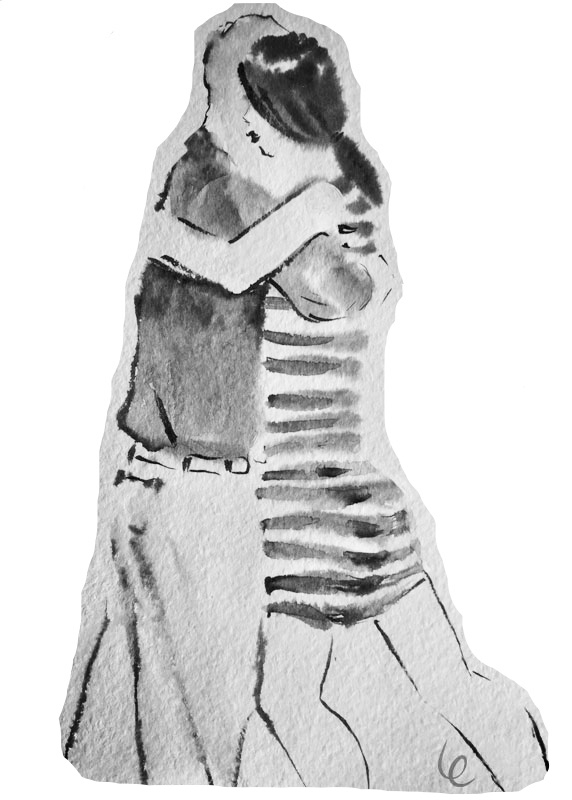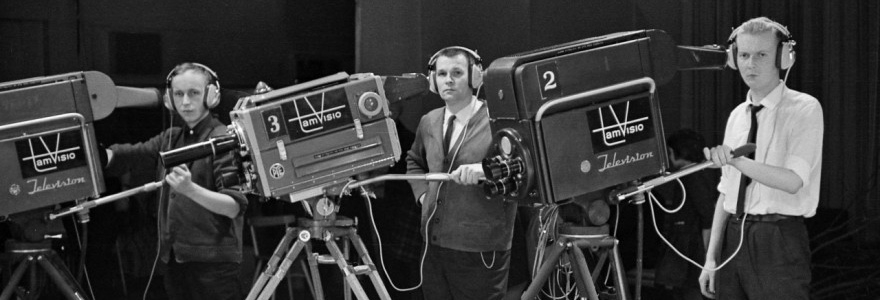ALEKSEY VAYS
On tango traffic and inner zen
At the end of a tango marathon a wonderful tanguera and I are dancing to some tragedy, everyone is very serious. The traffic is good, so when the following occurs, it catches me off guard: someone is pressing his back against mine — we didn’t crash; someone is deliberately and insistently pressing against me, like a bear pressing his back against a tree. Speechless, continuing to embrace my partner, I turn half-way back, and then — if you’ve seen Semeon, you’ll understand — slowly raise my head and see Semeon slyly smiling at me. I laugh, the tragedy is ruined, the practical joke is a hit.
The next day at the afterparty I really felt the essence of this wonderful trolling, when we lightly bumped backs with the couple behind us by accident — I was immediately amused, without getting irritated. It became clear to me that irritation was my first reaction to accidents on the dancefloor. Indeed, how can you not get irritated? Say, you’re dancing with a lovely tanguera to your favorite orchestra, you’re on cloud nine of kitty-trance, from which you’re being brazenly yanked by a hit, or — even worse — by a heel, followed by a "control shot" look of death, fired by the leader of the couple that hit you in the first place! Sometimes the question begs to be asked, when the trouble-navigator next to you throws his partner (what ronda?) from one free space to another, or when he "clears" the space around himself on a crowded dancefloor with an unending tornado of sharp heels: "Where are you right now? Are you even aware that there are people around you, that there is a lady in your arms?"
We get irritated when the world does not correspond to our expectations, when our worldview is at a dissonance with reality. You were expecting trance, but you received pain. You were expecting polite and sensitive gentlemen, but you’re next to a snob in the "you're all in my way" mode. Irritation in such cases is kind of a default reaction — like a muscle spasm when the doctor’s mallet hits your leg below the kneecap. Action — reaction. But irritation is just one of the ways to react when we experience cognitive dissonance. The reality of the matter is that we have a choice of our attitude toward this, and, therefore, we can choose the way, in which we respond.
The next day at the afterparty I really felt the essence of this wonderful trolling, when we lightly bumped backs with the couple behind us by accident — I was immediately amused, without getting irritated. It became clear to me that irritation was my first reaction to accidents on the dancefloor. Indeed, how can you not get irritated? Say, you’re dancing with a lovely tanguera to your favorite orchestra, you’re on cloud nine of kitty-trance, from which you’re being brazenly yanked by a hit, or — even worse — by a heel, followed by a "control shot" look of death, fired by the leader of the couple that hit you in the first place! Sometimes the question begs to be asked, when the trouble-navigator next to you throws his partner (what ronda?) from one free space to another, or when he "clears" the space around himself on a crowded dancefloor with an unending tornado of sharp heels: "Where are you right now? Are you even aware that there are people around you, that there is a lady in your arms?"
We get irritated when the world does not correspond to our expectations, when our worldview is at a dissonance with reality. You were expecting trance, but you received pain. You were expecting polite and sensitive gentlemen, but you’re next to a snob in the "you're all in my way" mode. Irritation in such cases is kind of a default reaction — like a muscle spasm when the doctor’s mallet hits your leg below the kneecap. Action — reaction. But irritation is just one of the ways to react when we experience cognitive dissonance. The reality of the matter is that we have a choice of our attitude toward this, and, therefore, we can choose the way, in which we respond.
"How people treat you is their karma; how you react is yours." – Wayne Dyer

Illustration by Eugenia Chernikova
Accidents in social tango happen, and sometimes these accidents cause physical pain. No matter how carefully we follow navigation rules, we, unfortunately, cannot avoid this. But we can avoid aggravating our physical pain with subsequent psychological self-poisoning. I’m talking about cases, when our default reaction — left uncontrolled — grows from irritation into anger or a grudge. We hold onto the cognitive dissonance, keeping it inside ourselves with some subconscious goal: to prove that the world is not perfect, for example, or to restore justice. It is unlikely that holding on to anger or grudges will help you attain this goal, but it very well may ruin your mood and health.
What other ways are there to respond? I think that the most suitable response in case of an accident on the dance floor is to verbally apologize and to mentally forgive everyone involved, regardless of whose fault it was, and which one of you is in pain. And sincerity is quite important here. First, when we apologize, we acknowledge that something unwanted took place. Second, we affirm that it wasn’t done on purpose. Third, by stating our regret, we let go of our cognitive dissonance without further poisoning ourselves. Fourth, we allow the others involved to do the same.
So why don’t we always apologize? Sometimes the hit is very light. Sometimes we don’t want to stop the dance. In these cases the incident remains unresolved, "as is." Most of the time it is easier to think that the other couple is to blame. "Why would I apologize? It’s me/my partner, who’s experiencing pain. They’re the ones, who should apologize." We equate apology with humiliation, especially in cases, when it’s not obvious who is to blame. I try to approach this differently, and I hope that you may find this perspective useful.
What other ways are there to respond? I think that the most suitable response in case of an accident on the dance floor is to verbally apologize and to mentally forgive everyone involved, regardless of whose fault it was, and which one of you is in pain. And sincerity is quite important here. First, when we apologize, we acknowledge that something unwanted took place. Second, we affirm that it wasn’t done on purpose. Third, by stating our regret, we let go of our cognitive dissonance without further poisoning ourselves. Fourth, we allow the others involved to do the same.
So why don’t we always apologize? Sometimes the hit is very light. Sometimes we don’t want to stop the dance. In these cases the incident remains unresolved, "as is." Most of the time it is easier to think that the other couple is to blame. "Why would I apologize? It’s me/my partner, who’s experiencing pain. They’re the ones, who should apologize." We equate apology with humiliation, especially in cases, when it’s not obvious who is to blame. I try to approach this differently, and I hope that you may find this perspective useful.

Illustration by Eugenia Chernikova
When I apologize, I express my regret that the incident occurred in the first place. I take full responsibility for participating in the incident. I don’t try to determine who is to blame or to serve justice: even if it’s not my fault, I’m just as sorry for having participated in the incident, as if it would have happened because of my carelessness. I don’t wait until "they apologize," the response of the other couple is their business entirely. If I’m experiencing pain, then by apologizing I ask forgiveness of my body as well. Hawaiian healing practice Ho’oponopono, for example, comes down to repeating the phrases "thank you, I’m sorry, please forgive me, I love you," half of which have to do with apologizing.
At the same marathon, when a brilliant tanguera and I entered the dancefloor, we both noticed that the traffic was rough — the marathon was just beginning. Before embracing me, my partner did the following: she closed her eyes for a second, and, having straightened her posture and lowered her shoulders, she gestured her hands to the sides and down, as if claiming our space. I noted to myself that I usually perform a similar ritual in my mind: declaring our borders is the first safety precaution.
There are many parallels drawn between life situations and tango, and this one is quite important: safety first. More important than musicality, even more important than comfort. In social tango we are far from alone. And even though we cannot control the decisions of others, the right to choose our actions — regarding safety, responsibility, even our state — always belongs to us.
At the same marathon, when a brilliant tanguera and I entered the dancefloor, we both noticed that the traffic was rough — the marathon was just beginning. Before embracing me, my partner did the following: she closed her eyes for a second, and, having straightened her posture and lowered her shoulders, she gestured her hands to the sides and down, as if claiming our space. I noted to myself that I usually perform a similar ritual in my mind: declaring our borders is the first safety precaution.
There are many parallels drawn between life situations and tango, and this one is quite important: safety first. More important than musicality, even more important than comfort. In social tango we are far from alone. And even though we cannot control the decisions of others, the right to choose our actions — regarding safety, responsibility, even our state — always belongs to us.
Author: Aleksey Vays. Opinions expressed in articles within this blog may not coincide with those of the editor.
Subscribe to Simple&Elegant Blog to keep in touch!
We use cookies and other metadata to provide the best experience. If you don't agree with the Policy, you can leave the site.
Ok, thanks!
All text, photo and video materials belong to their owners.
Reference to the source is obligatory.
Photo and other credits: Dream Team
© Elegance is Simple. All Rights Reserved.
hello@simplenelegant.com
Reference to the source is obligatory.
Photo and other credits: Dream Team
© Elegance is Simple. All Rights Reserved.
hello@simplenelegant.com

Dream Team
Video, Editing and Creative Support - Daria Ermolaeva
Video Operating - Vladimir Kutakhov
Animation - Evgenja Chernikova
Design - Anastasia Rotar
Blog Editing and Translation - Dunya Valova
Photo - Anya Semenyuk, Daria Ermolaeva, Viktoria Fedirko, Maria Mosolova, Dmitry Volkov, kaboompics.com, imagefinder.co, freestock.org, gratisography.com, facebook.com
All photos are used with the permission of their owners and/or have an open license.
Video Operating - Vladimir Kutakhov
Animation - Evgenja Chernikova
Design - Anastasia Rotar
Blog Editing and Translation - Dunya Valova
Photo - Anya Semenyuk, Daria Ermolaeva, Viktoria Fedirko, Maria Mosolova, Dmitry Volkov, kaboompics.com, imagefinder.co, freestock.org, gratisography.com, facebook.com
All photos are used with the permission of their owners and/or have an open license.

